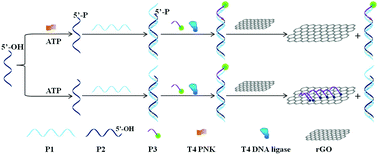A novel fluorescence method for activity assay and drug screening of T4 PNK by coupling rGO with ligase reaction†
Abstract
T4 polynucleotide kinase (PNK) is the primary member of the 5′-kinase family that can transfer the γ-phosphate residue of ATP to the 5′-hydroxyl group of oligonucleotides. In this article, using the differential quenching ability of reduced graphene oxide (rGO) towards the fluorophore-labeled DNA probe, we propose a novel method for detecting T4 PNK activity assisted by ligase reaction. Under the optimized conditions, the detection limit of T4 PNK was estimated to be 0.0002 U μL−1 in the linear region of 0.001 U μL−1–0.1 U μL−1. Additionally, the developed method was used to screen regulators of T4 PNK from natural compounds. The compound f isolated from the root of Kadsura coccinea (Lem.) A.C. Smith was found to stimulate T4 PNK activity in a concentration-dependent manner in vitro. Finally, the method was used to monitor the relation of T4 PNK activity with pelvic inflammatory disease (PID). The results demonstrated that the development of this disease could inhibit T4 PNK activity to some extent. In summary, the above data indicate that the method not only provides a universal platform for monitoring T4 PNK activity, but also shows great potential to be used in drug screening and clinic diagnosis.



 Please wait while we load your content...
Please wait while we load your content...